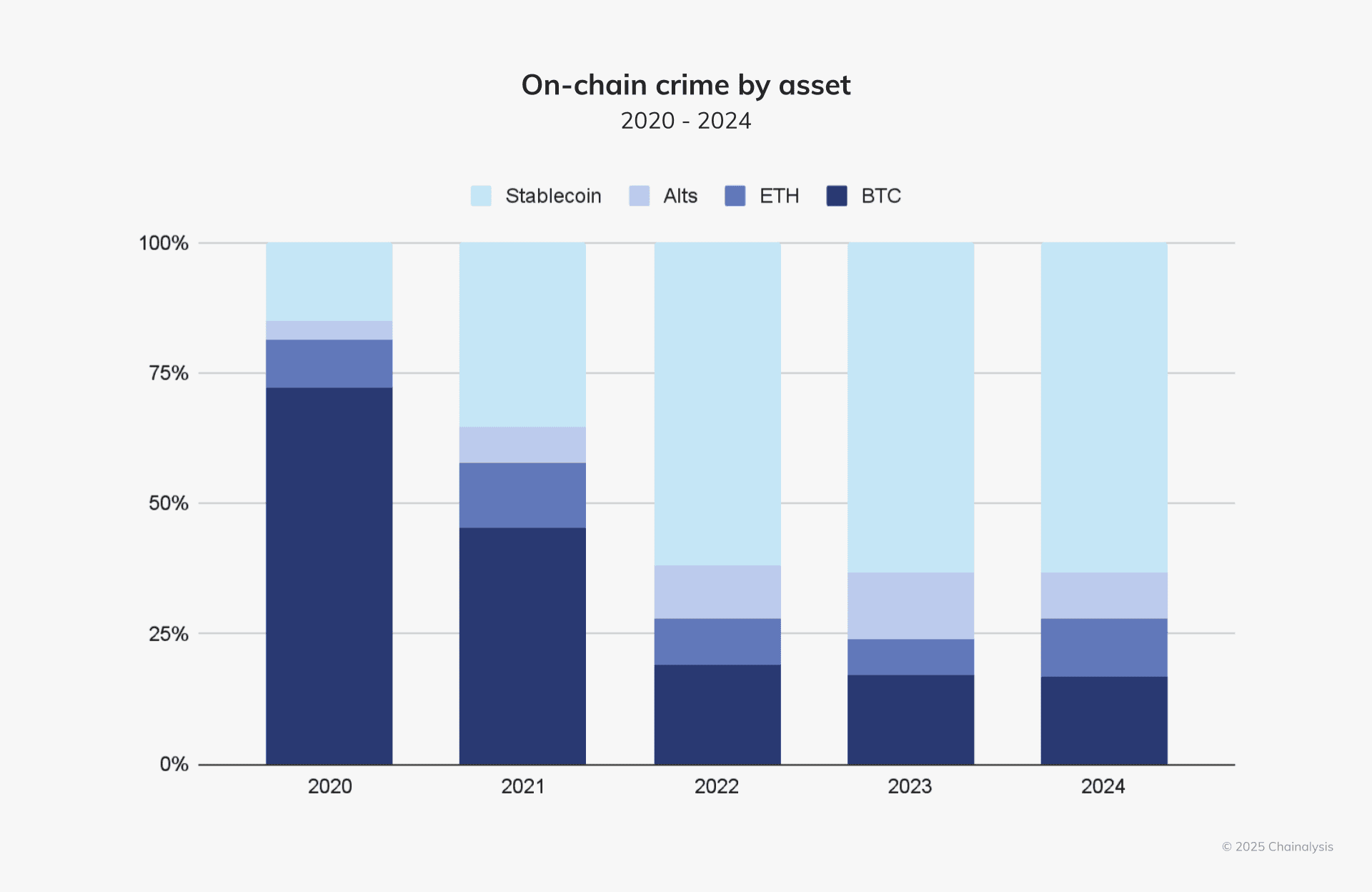Bitcoin’s explosive growth continues to challenge the traditional financial sector, but misinformation remains one of the biggest barriers to adoption. Many investors lose out on significant returns because of persistent misconceptions and myths. Here are the five most common—and costly—Bitcoin mistakes, debunked with facts and up-to-date analysis.
1. Only Criminals Use Bitcoin
The association of Bitcoin with criminal activity stems from its early history, when it was used on darknet markets like Silk Road. Today, the reality is very different. Bitcoin is a fully regulated, institutional-grade asset. Major U.S. and global asset managers have launched Bitcoin ETFs, and conservative banks are entering the space.
Data tells the true story: According to Chainalysis, criminal transactions represent just 0.14% of all crypto activity. Of that, less than 20% involves Bitcoin—the majority now flows through other assets such as stablecoins and altcoins. Meanwhile, the share of global GDP used for illicit activity in cash (USD, EUR, etc.) is estimated at 2–5%. In other words, fiat currency is far more frequently used in crime.
 Bitcoin’s share of crypto crime keeps falling | Source: Chainalysis
Bitcoin’s share of crypto crime keeps falling | Source: ChainalysisMissing the point: Avoiding Bitcoin because of outdated crime stereotypes ignores the data—and could mean missing out on one of the most innovative, regulated investment ecosystems available.
2. Bitcoin Has No Intrinsic Value
Critics argue that, since Bitcoin isn’t “backed” by gold or a physical commodity, it’s fundamentally worthless. Yet, the same is true for the U.S. dollar and euro: neither has been gold-backed for decades. Their value derives from trust in the system.
What gives Bitcoin value? - Scarcity: Only 21 million coins will ever exist.
- Decentralization and security: Maintained by thousands of nodes worldwide.
- Utility: Bitcoin is increasingly adopted by both individuals and institutions as a store of value and for payments.
Institutional demand is real: U.S. spot Bitcoin ETFs now control almost 600,000 BTC—about 3% of the total supply. Corporations like Strategy (formerly MicroStrategy) and Metaplanet use BTC as a strategic treasury reserve, not a speculative bet.
Real-world impact: In many emerging economies, Bitcoin serves as a censorship-resistant payment tool, especially where traditional banking is unavailable. Human rights activists leverage BTC for remittances and financial inclusion, while investors in developed markets use it for portfolio diversification and long-term growth.
The S&P 500 is as volatile as bitcoin now pic.twitter.com/OrO68Z0HiS
— Eric Balchunas (@EricBalchunas) April 10, 2025
Smart investing means seeing value in scarcity, global use, and secure technology—not just physical backing.
3. Bitcoin Is Too Volatile for Serious Investment
Volatility is a hallmark of new, disruptive assets—and Bitcoin is no exception. Daily price swings of thousands of dollars are common. But historical and current data show that as Bitcoin’s market cap grows, its volatility trends downward.
Current facts: According to Coinglass, BTC’s annualized volatility is around 1.7%, significantly lower than during its early years. This drop in volatility is typical for maturing assets—compare to the early years of tech stocks or even the S&P 500 during periods of innovation.
 Long-term decline in Bitcoin volatility | Source: Coinglass
Long-term decline in Bitcoin volatility | Source: CoinglassPerspective: While short-term traders face risks, long-term investors who hold through volatility have historically enjoyed strong positive returns. Volatility has mostly been “upwards”—and missing out on those moves is often the biggest mistake.
Conclusion: Volatility is the price of outperformance. The best-performing asset of the last decade remains Bitcoin.
4. Bitcoin Is Too Expensive—Only for the Wealthy
The current price of a single Bitcoin (over $115,000) leads some to believe it’s inaccessible. This is misleading: Bitcoin is divisible into 100 million satoshis, named after its creator. Today, one satoshi costs about $0.00115, making it possible to invest with just a few dollars.
Accessibility: Most exchanges enable users to buy fractions of a Bitcoin. You don’t need to purchase a whole coin. Investors of all sizes can participate, just as you don’t need to buy a full share of expensive stocks like Amazon or Google.
Price ≠ Value: Throughout Bitcoin’s history, “too expensive” has often meant “ready to go higher.” In 2017, investors hesitated at $3,000 per coin—now, that price is considered a bargain. What matters is the long-term potential, not the sticker price.
Smart strategy: Invest what you can afford, regularly. Don’t let big numbers scare you away from potential upside.
5. The Bitcoin Network Can Be Shut Down
A common fear is that governments or coordinated attacks could simply switch off Bitcoin. In reality, Bitcoin’s security comes from global decentralization. Thousands of nodes and miners maintain the blockchain—shutting it down would require controlling more than 50% of the network’s computing power (a “51% attack”), which is economically and logistically nearly impossible.
Network resilience in practice: In 2017, the so-called blocksize war saw some of the largest crypto companies attempt to force changes on the network. The decentralized community rejected centralizing proposals, demonstrating the true robustness and democratic nature of Bitcoin’s protocol.
Regulatory reality: Most governments now regulate access points (exchanges, banks) rather than trying to “turn off” the network. Even in countries that have attempted outright bans, Bitcoin usage and mining have continued via decentralized or peer-to-peer channels.
The true risk isn’t shutdown—it’s not understanding how resilient and adaptable the network truly is.
Conclusion: Outdated Myths Don’t Stop Bitcoin—But They Might Stop Your Profits
Whether concerns are about crime, value, volatility, accessibility, or systemic risk, none hold up to the facts. Bitcoin is no longer a fringe technology: it’s a global financial infrastructure supported by robust data, institutional adoption, and real-world utility. Investors who move past the myths—and focus on data—are best positioned for the next chapter in crypto’s evolution.




